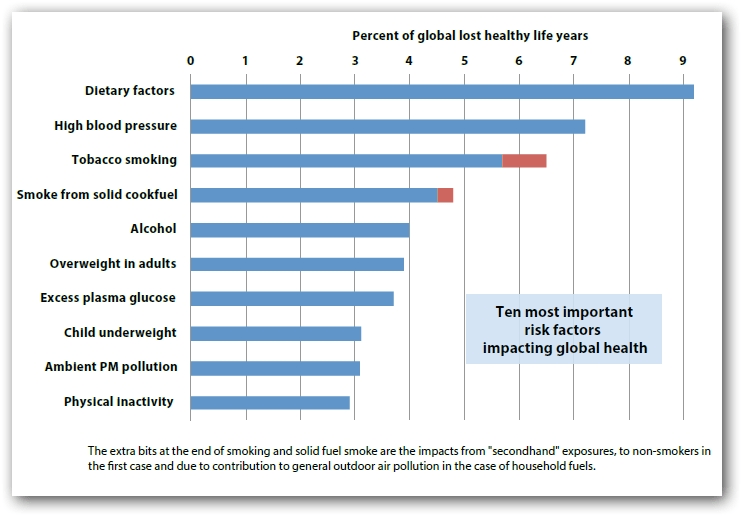The fracking furor over shale gas is the latest in a series of environmental debates that have bedeviled the oil and gas industry in spite of what might be considered an enviable record compared to related industries, coal for example. From off shore spills to the Keystone Pipeline, the industry probably feels a bit set upon at times. Similarly, its products are often the focus of environmental concern and consequent strict regulation, for example diesel air pollution. Finally, it often bears the brunt of concerns about carbon dioxide emissions leading to climate change risks.
The industry might keep in mind, however, that one of its products, liquefied petroleum gas (LPG bottled gas containing propane and butane), is actually the most effective solution available for the largest environmental health risk in the world: cooking with solid fuels.
In the latest Global Burden of Disease assessment (GBD), it is estimated that smoke from daily use of solid fuels for cooking is responsible for 3.9 million premature deaths annually, mostly in the form of child pneumonia and chronic lung and circulatory diseases in adults. Highly polluting biomass (wood, crop residues, and dung) and coal cookfuels together account for nearly 5% of the lost healthy life years from all causes globally, making them the largest environmental health hazard. The figure shows how it compares to the other top-10 risk factors of all kinds – coming in fourth globally in terms of lost healthy life years. Because women and their youngest children receive the highest exposures to the smoke, it is the largest single risk factor for women and girls in many poor countries.
Such assessments are done by comparing the health impact of existing household pollution levels with those of a hypothetical counterfactual level, since zero pollution is not feasible. For the GBD, the pollution level equivalent to cooking with ventilated LPG was taken as the feasible counterfactual because it is usually first clean fuel that people use when moving away from biomass. Thus, the bar marked “smoke from solid cookfuel” in the figure could just as easily been titled “lack of LPG for cooking.” Almost by definition, LPG offers a full solution.
It is not a solution, however, if people do not have access to it. Unfortunately, although the fraction of people worldwide using clean fuels for cooking has been rising to balance population growth, the number of households using solid fuels has stagnated at about 2.8 billion people for at least two decades. Indeed there are more people using such fuels for cooking today than the entire world population in 1955. In terms of the absolute impact on health, therefore, accelerated efforts will be needed to reduce this major health hazard among the world’s poor populations.
Although the biggest constraint is cost, there are other barriers to more widespread LPG use. Reliable supplies are still elusive in many rural areas where distribution networks operate poorly with slow outmoded procedures and weak infrastructures. More innovative financing approaches both for distributors and consumers, perhaps relying on smart phones and other modern systems, need to be promoted. Downstream technology in the industry also tends to be ancient, when smaller, lighter, safer LPG cylinders and associated management systems offer greater penetration to poor populations. The stove combustion technology tends to be old as well, when newer inexpensive burners offer substantial improvements in cooking efficiency. Every increase in reliability and efficiency essentially makes meals more affordable for that many more people and allows viable distribution networks to operate in more areas.
Even cost needs to be considered more broadly. While it is unlikely that the poorest households can currently afford full price for LPG, the needed societal support to make up the difference would not be wasted. In India, for example, the economic value of the health improvement and time-savings of a switch from biomass to LPG averages about US$300 per household every year, more than the full cost of the LPG. The benefits accrue to society as a whole, however, while the needed investment in the LPG would come from the government, likely through the oil and gas sector. The imbalance creates substantial political and financial tensions.
There is some opposition in the environmental community to promoting LPG, a fossil fuel, because of climate concerns. In reality, however, because of the poor combustion typical in biomass stoves, which produces black carbon, methane, and other climate-active pollutants, and the often non-renewable nature of the biomass supplies, which results in CO2 emissions, the net climate impact of a switch to LPG would be negligible. Even if only considering CO2, the incremental impact on global emissions of a switch to LPG would be no more than a percent of the emissions from the developed sector globally. It is not cooking by the poor that poses risk to the climate.
There are two important bottom lines. First, the oil and gas industry should be proud that it has a product that is an environmental hero of major proportions – it is the only currently available product to convincingly attack the largest environmental health threat globally. In addition, driven by the great expansion of natural gas supply globally, the byproduct LPG, in the form of “natural gas liquids,” is potentially posed to be much more widely available for this market.
Second, to honestly take full credit for this beneficial product and to effectively open up the billion new customers it represents, however, the industry should apply its substantial resources and capacity to promote large-scale innovations to help governments and others accelerate the natural movement of populations to clean and convenient fuels for cooking. Let’s not have 2.8 billion still stuck with dirty cookfuels after many more decades, when clean fuels are available for all today.
Prof. Smith is a professor of Global Environmental Health at the University of California, Berkeley.
Originally printed as a guest op-ed for Forbes, May 27, 2014
MAHB-UTS Blogs are a joint venture between the University of Technology Sydney and the Millennium Alliance for Humanity and the Biosphere. Questions should be directed to joan@mahbonline.org
MAHB Blog: https://mahb.stanford.edu/blog/the-petroleum-product-that-can-save-millions-of-lives-each-year/
The views and opinions expressed through the MAHB Website are those of the contributing authors and do not necessarily reflect an official position of the MAHB. The MAHB aims to share a range of perspectives and welcomes the discussions that they prompt.

